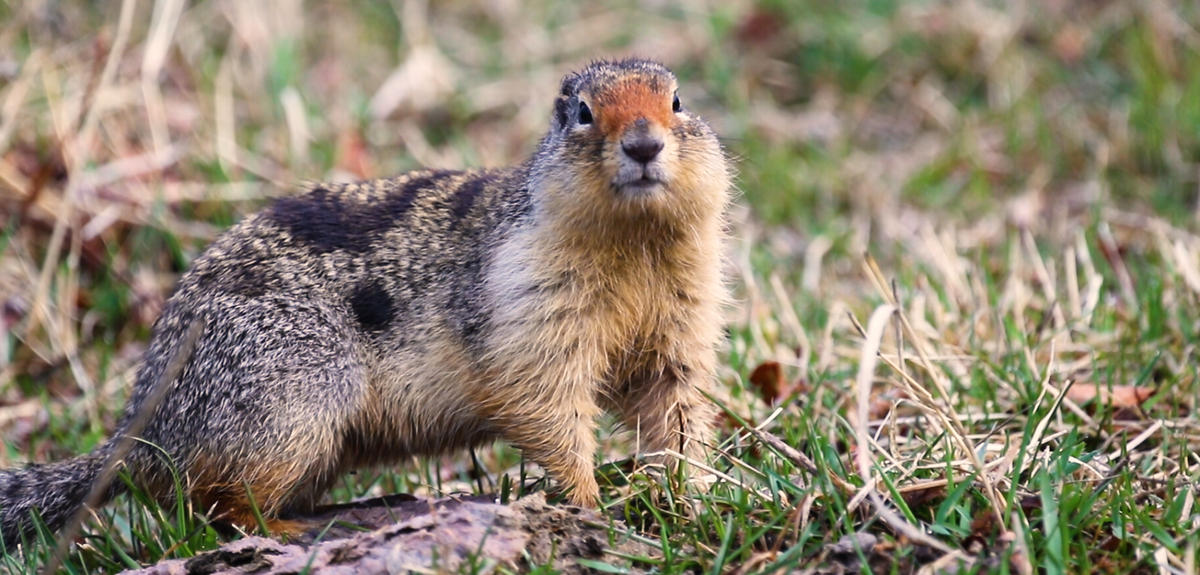You are here
Ahhh the benefits of collective living.
It’s undeniable, being part of a group provides many advantages.
Whether it’s resisting parasites, building a home, looking for food, or even escaping predators.
But is life in community always beneficial to the members of a group? Maybe this Canadian ground squirrel should be a bit more concerned about its peers.
In the land of this particular ground squirrel, spermophilus, the mating season is exceptionally short. Female ground squirrels are only fertile for a single day - creating a social environment fraught with conflict.
An international research team is working to understand the complexity of these mammals’ social relationships in the heart of the Canadian Rockies. This species has been studied for the last 27 years on this prairie within the Sheep River provincial park in Alberta.
Vincent Viblanc – Biologist
“In this long term study we’re able to very closely follow and understand each individual squirrel, from birth to death and observe their social progress over the entirety of their life.”
By following these squirrels long term, Vincent and his colleagues have a mountain of data at their disposal concerning each individual’s history: age, how many offspring they care for, and also parental lineage.
Over time, the researchers discovered that certain ground squirrels reproduced less than others. They suppose that the differences observed might be due to the quality of their social environment and the resulting stress.
In order to test this hypothesis, Vincent’s team must first understand the group’s social organization, across its 70 members.
Vincent Viblanc – Still a Biologist
“We have three observers on three different platforms covering the area we are studying. So when we see a social interaction between two individuals, whether it’s aggressive or friendly, we can make note of it.”
Identifying individuals from a distance is made possible thanks to unique symbols painted on the back of each animal. All season long, the scientists gather data on their behavior and location. When combined, this information enables mapping of the colony’s social structure.
Vincent Viblanc – Biologizing
“The point of this behavioral survey is to correlate it to physiological measurements we’ll take from individual squirrels.”
Stress levels for each squirrel are measurable thanks to different biological samples. The secret to capturing these ground squirrels lies in an irresistible bait… peanut butter.
Every year, this squirrel’s appetite for peanuts drives it into Vincent’s hands for a brief assessment. Blood and fecal samples contain measurable levels of hormones linked to stress.
The scientists also collect DNA samples from mouth swabs. The collected cells will be analyzed to estimate above normal cellular aging, potentially driven by the squirrel’s stressful social context.
A few months later, the data collected in Canada is being analyzed in Strasbourg, in the East of France
The behavioral data can now be represented visually in the form of a social web.
Sebastian Sosa – Ethologist (Animal behaviorist, if you were curious)
“So here, the collection of individuals within the colony are represented, the males in red and the females in blue. And now we can see the ensemble of aggressive interactions between individuals over the course of the season.”
This diagram enables a comparison of individuals within the social network and a visualization of the number of aggressors… and victims.
Now each squirrel’s stress levels can be measured through a variety of lab analyses of the biological samples collected in the field.
Mathilde Lejeune – Biochemist
“I’m measuring the antioxidant defenses in our samples. For this one I’m using this indented plate. Then I add a reactive agent which should produce a chemical reaction and colored substrate, and from that color I can deduce the level of its antioxidant defense system.”
Measuring how much light the samples absorb in a spectrometer will reveal the stress levels for each individual.
The researchers have already demonstrated that squirrels outside of defined family groups are subject to more aggressive behaviour, exhibiting higher levels of stress. They also raise smaller litters.
Conversely, ground squirrels surrounded closely by family benefit from a much less aggressive social climate, giving them more time to dedicate to their young and encouraging larger litters.
But it isn’t quite as simple as that! The research also shows that above a certain number of individuals in a family unit, stress levels can rise again. These results suggest that the domineering behavior of relatives can create stress which counteracts the benefits of a family group.
Vincent’s questions don’t stop with the study of social stress among adult ground squirrels.
Vincent Viblanc
“What interests us as well is to try and understand how stress could be transmitted to successive generations, and how the social environment created by parents will influence the development of their young, whether positively or negatively.”
In the midst of mixing demographics, animal behavior, and physiology, these studies are still some way from uncovering the full picture. But it’s already clear that Canadian ground squirrels aren’t the only ones affected negatively by their entourage.
These studies could enable a better understanding of the effects of stress on other animal species, but also reveal certain realities within our own human societies.
What stressed squirrels can teach us
As we have learned in these times of social distancing, living in close-knit communities can be, in certain cases, quite detrimental to individuals! An international team of researchers is studying Canadian ground squirrels to understand how their social organisation affects their health.
Sebastian Sosa
Mathilde Lejeune
Institut Pluridisciplinaire Hubert Curien (IPHC)
CNRS / Université de Strasbourg





